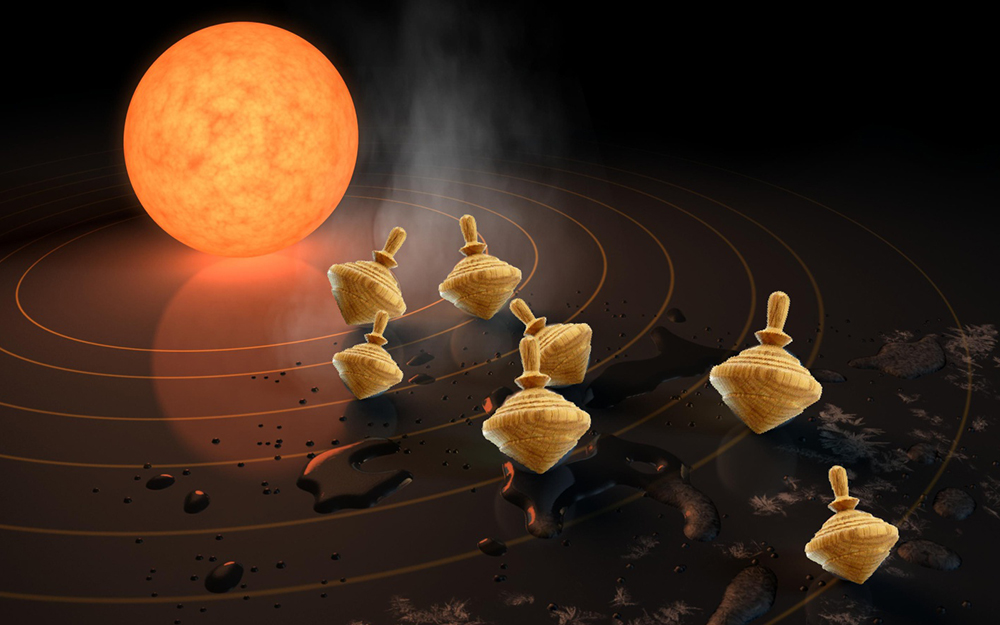Super-Earths Have Weird Orbits Because They’re Permanently Off-Kilter

Throughout the Milky Way galaxy, pairs of "super-Earths" circle distant stars.
At first glance, all seems right with these alien worlds. But when astronomers looked closer, they realized the orbits of these super-Earth pairs didn’t follow the normal rules.
Now it's clear why: These planets are permanently off-kilter — tipped over on their sides, new research suggests. [9 Most Intriguing Earth-Like Planets]
Between 2009 and 2013, NASA's exoplanet-hunting Kepler mission discovered that super-Earths, or rocky exoplanets that are larger than Earth but smaller than Neptune, orbit approximately 30 percent of known stars that are similar to our sun. Their orbits are roughly circular and take less than 100 days to complete.
When planets orbit near each other, they usually settle into a stable pattern known as "orbital resonance," in which the timing of their orbits is locked together. For example, the planet that's closer to the star will orbit twice during the time it takes for the farther star to orbit once, creating an orbital period with a ratio of 2-to-1. Another common ratio for planetary orbits is 3-to-2 — three orbits of the closer planet for two orbits of the planet that's farther away, lead study author Sarah Millholland, a doctoral candidate in the Astronomy Department at Yale University in Connecticut, told Live Science in an email.
But many of the paired exoplanets found by Kepler defied those rules.
"The unusual puzzle is that there is an overabundance of planetary systems with pairs of planets having a ratio of their orbital periods just wide of the 2:1 and 3:2 ratios," Millholland said.
Sign up for the Live Science daily newsletter now
Get the world’s most fascinating discoveries delivered straight to your inbox.
Something was nudging these planets' orbits — but what was it? Past studies proposed that planetary tides could play a part by absorbing orbital energy as heat; this could tug the planets into orbits that slightly exceeded the usual ratios, according to the study.
But that explanation would only work if tides were sucking up energy far more efficiently than expected, the researchers wrote. However, when a planet is dramatically tilted on its axis, the star it orbits exerts a stronger pull on its tides. More powerful tides absorb more orbital energy — enough to "sculpt" a planet's orbit, Millholland said.
Researchers do not yet have direct measurements confirming that these planets have significant axial tilts that are greater than Earth's 23-degree tilt. But if their hypothesis is correct, their findings carry important implications for understanding weather and climate on distant worlds.
"These planets will have much more extreme seasons than the seasons that we experience here on Earth," with its modest tilt, Millholland told Live Science.
The findings were published online March 4 in the journal Nature Astronomy.
- Interstellar Space Travel: 7 Futuristic Spacecraft to Explore the Cosmos
- What a View: Amazing Astronaut Images of Earth
- 10 Exoplanets That Could Host Alien Life
Originally published on Live Science.

Mindy Weisberger is an editor at Scholastic and a former Live Science channel editor and senior writer. She has reported on general science, covering climate change, paleontology, biology and space. Mindy studied film at Columbia University; prior to Live Science she produced, wrote and directed media for the American Museum of Natural History in New York City. Her videos about dinosaurs, astrophysics, biodiversity and evolution appear in museums and science centers worldwide, earning awards such as the CINE Golden Eagle and the Communicator Award of Excellence. Her writing has also appeared in Scientific American, The Washington Post and How It Works Magazine. Her book "Rise of the Zombie Bugs: The Surprising Science of Parasitic Mind Control" will be published in spring 2025 by Johns Hopkins University Press.









